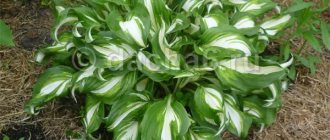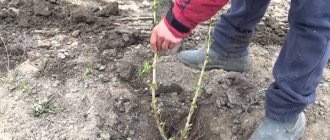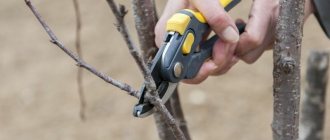Gooseberry is a small shrub reaching a height of one meter. It can be found wild in forests and as a cultivated plant in garden plots. A characteristic feature is a large number of thin sharp thorns on the branches. The leaves are round or heart-shaped, up to 6 cm long, covered with small fluff. Blooms greenish or reddish in May.
The fruits are oval or round berries up to 12-15 mm long, sometimes reaching 30 mm. Covered with bristles or bare, veins are visible on the transparent skin. The color when ripe is first green, yellow, and then with a reddish tint. Ripening time is July-August.
The plant is replanted in spring or autumn, most often choosing the last season, September-October. Reasons: leaves fall, growth slows down and sap flow stops, the roots have become stronger over the summer, the stems have matured. The preparation of the plant for wintering has already begun, and, being in the resting phase, it will more easily endure the move to a new place. The best time to work is cloudy weather.
Gooseberries can be replanted in the spring, but this is not advisable.
The fact is that he is the very first to awaken in the garden. If buds appear on it, it means that sap flow has begun and the root system has come to life. If you start replanting at this time, the roots can be damaged, reducing survival rate. Spring weather is changeable, temperatures are unstable, and therefore awakening can be missed. Summer replanting is carried out only if there is an urgent need to free up the area where the gooseberries grow.
Transplant times depending on region
The crop is grown throughout Russia, in the southern regions of Ukraine, and Crimea. The transplant season depends on the location:
- Northern regions of the Urals and Siberia: if the weather is good - early September, bad - August.
- Crimea, southern Ukraine - from mid-October to mid-November.
- Moscow region - from mid-September to October.
- Non-Black Earth region – October.
When can gooseberries be replanted?
Experienced experts say that berry crops can be replanted in autumn or spring, depending on the circumstances. The reasons why this is done are as follows:
- initially incorrectly chosen previous location for the bush;
- to rejuvenate an old plant;
- the bush grows greatly and does not receive enough light and nutrients.
Young gooseberry bushes take root best in a new place, which are also easier to replant.
in spring
Replanting gooseberries in the spring is not a good solution. But you have to carry out this procedure if you did not have time to do it in the fall. It is best to move the bushes from one place to another before the buds open, because if the buds are already swollen, the plant may not take root or may produce an insignificant harvest. In the southern regions, transplantation is recommended in March, in the northern regions - in April. For supporters of the lunar calendar, the optimal dates will be the days of the waxing moon, when energy accumulates, helping to quickly get used to new conditions.
You may be interested in information about what can be planted next to gooseberries.
in autumn
In autumn, it is most favorable to carry out activities to replant gooseberries. Basically, this process occurs at the end of September - beginning of October, when the bush completely sheds its leaves, before the first night frosts appear. During this period, the plant stops bearing fruit, remains dormant and adapts more easily to a new location.
Site selection and preparation
The choice of planting site is of great importance; the growth and yield of gooseberries depends on it. This is a sunny plant and it feels most comfortable in areas well warmed by the sun, protected from wind and drafts; it can be planted along a wall or fence.
Despite the fact that the plant loves moisture, it needs to be watered so that the water does not stagnate in the recesses around the trunk. Otherwise, there is a high risk of fungal diseases due to excessive moisture.
It grows well on light loamy soil; if the soil is loose, it is diluted with clay; if the soil is heavy, sand is added. The plant produces a rich harvest on black soil. When the soil is acidified, add lime and dolomite flour. Before transplanting, dig up the area well and remove weeds.
Gooseberries are not planted in the place where currants and raspberries grew before. The land there is depleted, barren and infected with fungal diseases.
Caring for transplanted plants
On moisture-retaining soils, transplanted bushes will require little additional watering and mulching of the soil.
Watering and fertilizing
Watering after transplantation is carried out every 3-4 days for 2 weeks. You need to water by moving away the layer of mulch, and you need to use settled water.
If gooseberries are transplanted in the fall, there is no need to fertilize the plant.
Find out what and how to fertilize gooseberries.
2 weeks after transplantation, preventive treatment of plants should be carried out against fungal diseases and pests that can settle on the shoots for the winter. Preventive drugs have proven themselves well: Bordeaux mixture and Nitrafen.
Mulching
The gooseberry bush will survive the winter safely if its tree trunk circle is mulched with a good layer of sawdust or dry leaves.
After each watering, the removed layer of mulch should be used to cover the tree trunk circle again.
Step-by-step transplant instructions
The place for transplantation is prepared in advance. A week or more before moving the bush, a hole is dug. This is necessary so that the seedling cannot go deeper into the ground over time. The width should be equal to the span of the roots, the depth should be up to 50 cm.
Step-by-step transplant instructions:
- Before digging up a bush, old branches are cut off, young and long ones are shortened by one third.
- Use pruning shears with long handles to trim trees. If there are a lot of branches on the bush, it is thinned out and the strongest and most mature ones are left.
- The ground is dug up approximately, the diameter is 40 cm, this is necessary to make the bush easier to reach.
- They dig up the bush with a shovel.
- Thick roots are cut off with an ax, small ones are left untouched.
- The entire lump of earth is lifted with a pitchfork and carefully transferred to the film without damaging the root system.
- The first layer of the hole is drainage, maybe gravel or broken brick.
- Add fertile soil mixed with humus and compost; all this should be of a homogeneous mass so that the roots are less damaged.
- Water is poured into the hole, 3-4 buckets, wait until it is absorbed, the seedling is placed in the middle of the hole, carefully covered with earth.
- The root collar is slightly lowered, approximately 6-8 cm below the soil surface. It is compacted and water is poured in again, topped up with soil, and compacted until the hole is filled with soil.
- The top is covered with mulch, the layer should be 5-10 cm above ground level. Over the winter it will sit down and level out.
Good care before the onset of frost will help the plant take root in its new location. It is watered once a week, before that the mulch is removed, and then put back in place. Sawdust is also used; in winter it will protect the root system from freezing, and subsequently serve as fertilizer. If the bush survived the winter, then next season there will be a good harvest.
2.How to plant gooseberries in a new place in the fall
For the transplant to be successful, you need to:
- choose a good place to place the seedling;
- dig a hole;
- prepare the ground;
- replant the plant correctly;
- provide care, prevention and watering.
2.1.Choice of location
If the plant is comfortable, it bears fruit well. Think in advance where it is better to plant the bush - a mistake can result in its illness and death. As practice shows, gooseberries feel good where there is access to sunlight and no wind.
As for the soil, the close occurrence of groundwater is dangerous, as is a large amount of clay impurities in the soil. These factors contribute to the appearance of fungus. Even if the bush survives, its fruits will be small and hard.
Choose a location taking into account the following requirements:
- adjust the composition of the soil - add clay to soil where there is a lot of sand and vice versa;
- Monitor the acidity level. If this indicator is higher than normal, extinguish it with a lime solution. It is absolutely safe for the plant. Add lime immediately before planting;
- Do not allow gooseberries to be adjacent to raspberries or currants. These crops are depleting the land. And their pests, grown in favorable conditions, will attack a weak bush and destroy it;
- Regardless of the structure and composition of the soil, before placing a seedling in it, the ground must be weeded.
2.2.Preparation of the site and soil
The size of the pit for autumn gooseberry transplantation is selected based on the composition and characteristics of the soil. According to the rules for planting crops, the optimal ratio is:
- 70x70x50 cm - for soil with a high content of silt;
- 50x50x50 cm - for favorable, light soil.
During the digging process, roughly divide the soil into two layers:
- the bottom one is of worse quality, remove it;
- top - add fertilizer to it. Mineral feed, compost or peat are suitable. If there is clay in the soil, mix in sand - this will fluff up the soil and make it light.
The ideal ratio of components for gooseberries is:
- peat part - one and a half buckets;
- compost - 1 bucket;
- phosphates - 0.25 kg;
- ash - 0.6 kg;
- crushed into crumbs, limestone - 0.25 kg.
Alternative composition:
- natural organics - 1 bucket. Rotted manure, weeds, foliage will do;
- ash - 100 g;
- phosphates - 50 g;
- potassium sulphide - 50 g.
Fill the hole 70% with the mixture, add clean soil on top. Fill the soil with 5 liters of water. After a week, the soil in the hole will be ready for planting.
2.3.Preparing the bush for replanting
To prevent the plant from being damaged, follow the following algorithm:
- prune the bushy part of the plant - cut off dry branches. It is enough for 6-7 shoots to remain on the plant. Trim each of them by 30%;
- prepare the roots - carefully remove the shoots. In order for the gooseberry to take root quickly, it will need strength. Too much growth will not allow this to be done;
- dig up the plant so that there is a distance of at least 30 cm from its center to the edge;
- If there are large root parts that extend beyond the circle, chop them off;
- use a shovel; if the bush is large, use a pitchfork and remove it from the hole. Place on oilcloth, blanket;
- move the plant to a new planting location.
Advice! If the plant is large, use replanting it as a propagation option - divide the bush into 3-4 fragments. The main condition is that each shoot must have a main and an accessory root.
Important! Replant the bush immediately after digging it out of the soil. Leaving the root system in the open air for a long time will cause it to dry out. As a result, the bush will hurt and may die. If it is not possible to transplant immediately, leave the plant in a bucket of warm water for 5-6 hours.
2.4. Landing
Step-by-step algorithm for autumn gooseberry transplantation:
- place a mixture of fertilizers in the hole - we discussed it in the section above;
- add some soil. Stir the soil;
- Sprinkle the mixture with plenty of water - 8-10 l;
- Insert the plant in the center, straighten the root system so that it is evenly located in the hole. The root ends should not protrude above the ground;
- Pour on top that part of the earth that was in the hole as the bottom layer - you previously dug it. The optimal layer height is 5-6 cm above the root neck;
- lightly compact the soil around the plant;
- take a pruner and remove the shoots from the seedling. There should be several buds left on each of them;
- dig a small hole around the bush - this is necessary for quality watering;
- mulch the ground with plant components or buy agrofibre. Such measures will speed up the adaptation time of the seedling.
2.5.Additional recommendations
An important condition for transplantation is the depth to which the seedling needs to be inserted. Adhere to the following condition - the depth of each subsequent transplant is 5-6 cm greater than the previous one. If the soil is dense and heavy, the difference is reduced to 3 cm.
Advice! If you are replanting a shrub that was previously in closed ground, try not to injure the plant - do not remove the earthen ball from the root system.
Plant the bush at a slight angle, making sure that there are no voids in the soil.
Possible errors and their consequences
Sometimes gardeners, considering gooseberries to be an unpretentious plant, do not quite adhere to the rules of replanting, regardless of whether it is carried out in the fall or in the spring:
- An adult bush does not take root well without a ball of earth; its roots must be dug out with a sufficient piece of soil.
- Rooters increase plant survival. Special preparations have been developed that are used during planting or transplantation. The most common is Kornevin, it is used as a biostimulant to accelerate the survival of a weakened root system.
- After transplanting the gooseberries to a new place, they are often watered with cold water. At the same time, they complain that the bush was planted in accordance with the deadlines, it was provided with normal care and timely watering, but the plant still dies. Favorable temperature for the plant is from +18 to +25 degrees, water should be settled or from a tap, it is strictly forbidden to use it from wells.
If you transplant gooseberries correctly, observing the timing of transplantation, as well as further care, the plant will take root well and will soon produce a rich harvest of berries.
Care after transplant
After transplanting a seedling in autumn, the plant requires virtually no care. The deep roots of the shrub allow the gardener to forget about watering for a long time. In the fall, it is necessary to add nitrate fertilizers, which help quickly fill the deficiency of microelements and bring a rich harvest. Weeds are regularly removed from around the plant and the soil is loosened. To reduce the appearance of weeds, as well as to protect against slugs and snails, the soil is mulched with straw, tree bark or grass clippings. If necessary, plantings are treated against garden pests. Gooseberries produce crops only on old, perennial shoots, so new shoots are pruned in the spring. They leave only 5-6 pieces from the new year.
Preparing the transplanted bush for wintering
Transplanted gooseberries in any season need careful preparation for wintering in order to produce a good harvest the following year. To do this, you must adhere to the following conditions:
- in the fall, after harvesting, treat the bushes with a 1% solution of Bordeaux mixture to prevent diseases;
- collect all fallen leaves and weeds from under the bushes;
- dig up the soil around the plants;
- pour several buckets of water under each gooseberry;
- spray the dug up soil with a weak solution of potassium permanganate;
- carry out sanitary pruning of the crown, cutting out dry and damaged shoots;
- Cover the tree trunk area with a 10 cm layer of mulch (humus or peat).











